| Monday, October 29, 2007 |
| The China Chronicles - The Terra Cotta Army |
I had been looking forward to this all year. My friend had to work for a couple of days, so I took advantage of her being occupied with other things and took a flight south some 600 miles to Xi'an to see one of the other great wonders of the world - the Terra Cotta Army of Emporer Qin Shi Huang.
Emporer Qin is credited with many things, among them, uniting China into the country we know today. He reigned from 247 BC to 210 BC, but he did it through tyranny, terror and autocratic rule. Regardless, he is not only known for the unification of China, but also for starting the Great Wall of China, building a system of national roads, establishing unified systems for law, weights and measures, and currency - and for the Terra Cotta Army which guards his as yet unopened tomb.
In 1974, three farmers were digging a well in Shanxi Province outside of Xi'an when they pulled up the head of one of the Terra Cotta warriors. Little did they know that they had stumbled on one of the great ancient treasures of our time. I was actually lucky enough to meet one of the three farmers, a man now well into his seventies, at the museum. He was kind enough to sign a book for me. Of the original three, only two of them survive, and they are regarded as national heroes.
It is believed that over 700,000 men were involved in creating Qin's tomb over a nearly 40 year period. Historical documents regarding the tomb itself say that Qin's body lies in a jeweled sarcophagus in a room where the ceiling has pearls for stars, and sits amid a scale model of his kingdom with seas and rivers of mercury. Ironically, it is believed that Qin died as a result of mercury poisoning. He was given tablets by his doctors who at the time, thought the metal contained valuable properties and could lead to immortality. Oooops.
Tests at the necropolis have indicated very high concentrations of mercury in the ground, but legend also has it that the tomb is rigged with "Indiana Jones" security systems and that arrows and other pitfalls await those who try to enter. The Chinese government is concerned about exposing the tomb to the elements, as sudden oxygenation after 2,200 years could cause many artifacts to disintegrate immediately upon contact with the air. They have considered covering the tomb in a large tent, but it would be like covering the pyramid at Giza, and no one makes one that big. After 2,200 years, another decade trying to get the technology in place to open the tomb properly is probably a wise move.
What the legends did not mention, was the magnificent Terra Cotta Army that Qin had buried up to a mile away from the tomb itself to guard it. Life size figures with individual faces and details that are simply amazing today, much less for being created more than 2 millenia ago before the birth of Christ.
The Army is currently housed in their original pits, where they were found. Three Pits have been partially excavated, and much debate remains as to exactly how many artifacts will be eventually found. They have excavated more than 8,000 figures and artifacts, and they've been digging for 40 years - as long as it took them to build the tomb in the first place. Active excavation is going on all the time, and it has become a life's work for more than a generation of Chinese archeologists.
All the King's Horses and All the King's Men This is Pit 1 - larger than most airplane hangars, it houses the majority of the figures discovered so far.
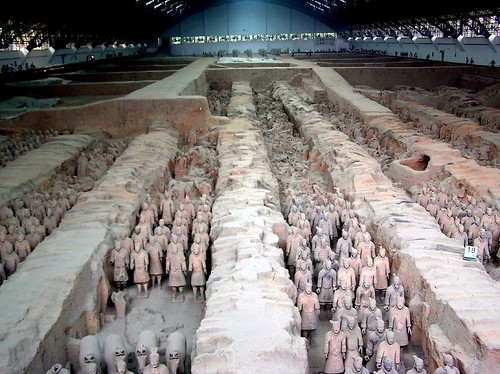
A closer look:
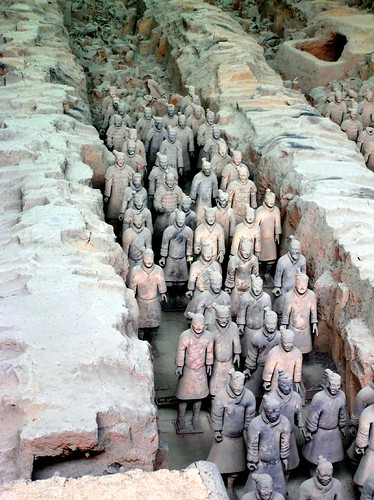
The photo below is remarkable in that you can still see bright yellow paint on the soldier's collar. All of the figurines were painted is bright, vivid colors when they were buried. These figurines are 2,200 years old. The detail is amazing:
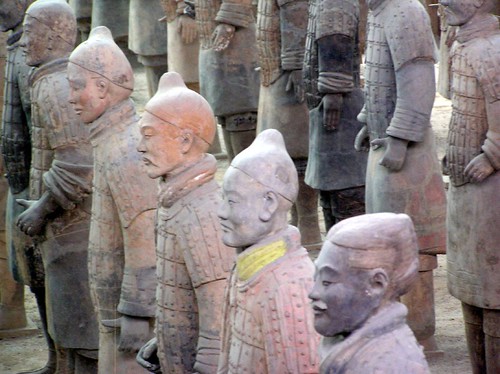
A charioteer and his steeds: What has been lost to time are the reigns and bridles for the horses. You can see that their mouths and his hands are posed to be holding them. Brass fittings remain, but the wooden chariots and leather have all disintegrated. Also remarkable is the level of technology used not only in creating the Warriors, but the brass plating and other metalurgical processes that the Chinese originated.

These guys have the unenviable task of trying to put Humpty Dumpty together again (and again, and again...)
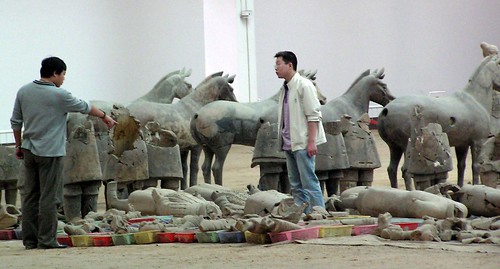
Five years after Qin's death, it is believed that a warlord sacked the Terra Cotta Army and set it ablaze. You can see the charred timber remains in the walls, and the scorch marks on these two warriors:
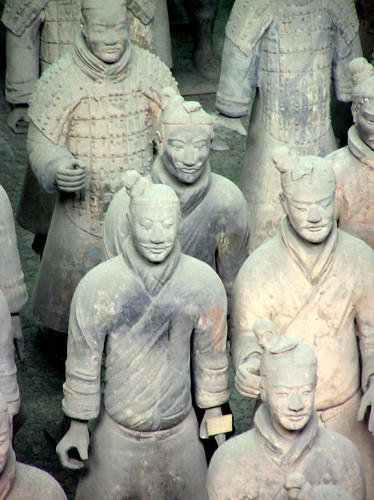
As one of the four ancient capitals of China, Xi'an is a city of some 3 million people, and its pollution threatens to exceed that of Beijing. There are other things to see and do here however, and tomorrow, we'll visit a few.
Next: The Wild Goose Pagoda, the Mosque, the Muslim Quarter, a Las Vegas show, and a Drum Corps. |
posted by Broadsheet @ 4:40 PM   |
|
| 2 Editorial Opinions: |
-
VERY jealous you got to see this with your own eyes. It must have been one of the most amazing things you've seen. Did you feel all the ancient spirits during your visit?
-
Damn. I can't believe you were there. I have chills just thinking about it, BS.
|
| |
| << Home |
| |
|
|


VERY jealous you got to see this with your own eyes. It must have been one of the most amazing things you've seen. Did you feel all the ancient spirits during your visit?